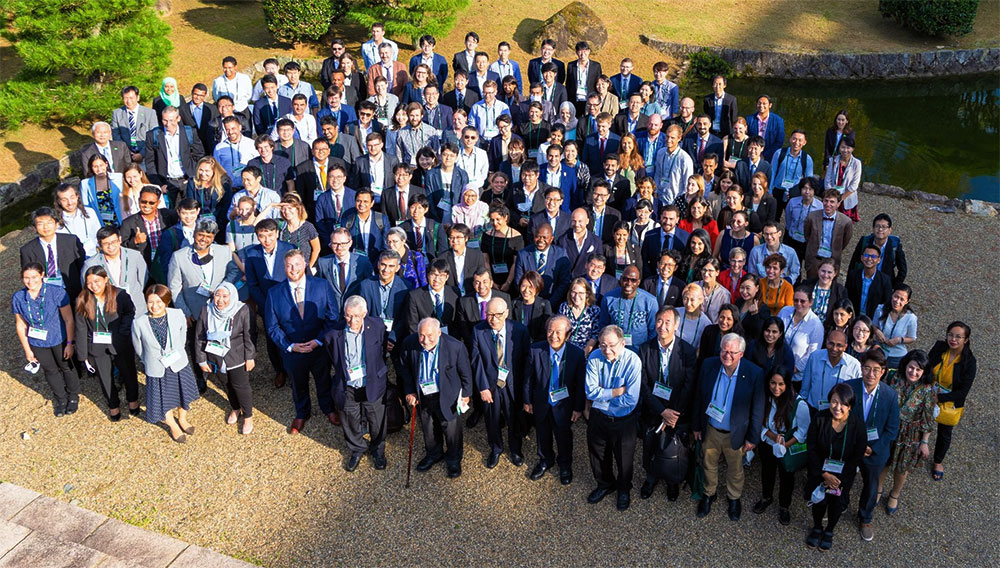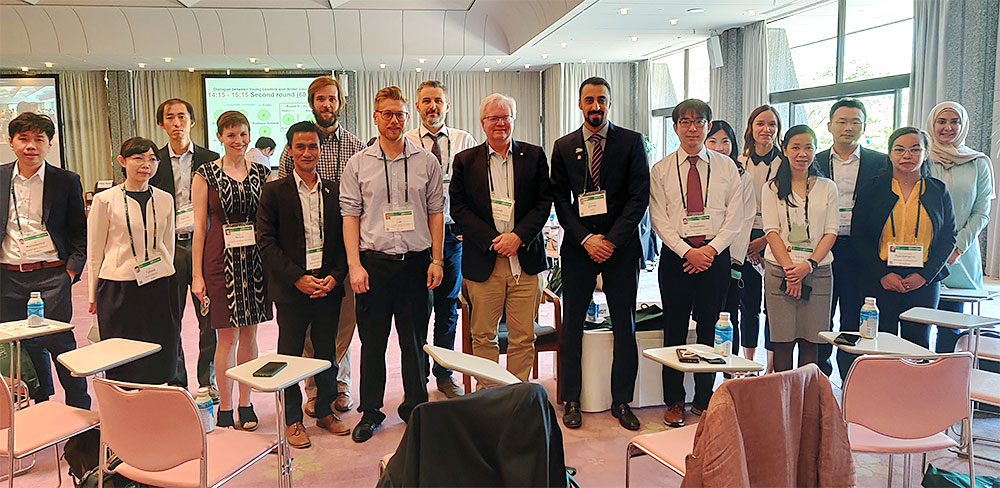Brookhaven Early Career Professionals Connect with Nobel Laureates in Kyoto, Japan
Megan Magrum, Daniel Forino, and Peter Denton attend the Science and Technology in Society forum as part of the Young Leaders Program
November 21, 2022
KYOTO, JAPAN – Three early-career professionals at the U.S. Department of Energy’s (DOE) Brookhaven National Laboratory had the opportunity to connect with Nobel laureates, discuss pressing global issues, and explore historic Kyoto, Japan at the 19th annual meeting of the Science and Technology in Society (STS) forum. The annual meeting, held from October 1 – 4 of this year, brought together nearly 1,000 leaders from around the globe representing organizations involved in science and technology, policymaking, business, and media.
Megan Magrum, a group leader in the lab’s Safety & Health Services Division, Daniel Forino, Division Manager within the lab’s Integrated Facility Management Division, and Peter Denton, Staff Physicist specializing in high energy theory, attended the three-day forum as part of STS’s Young Leaders Program. As an organization that looks to the future, STS implemented this program to encourage the participation and perspectives of exceptional young people in scientific and technical roles. Each of the representatives that were nominated from Brookhaven Lab came away from the experience with a unique perspective on the role that science and technology will play in the challenges ahead.
Building connections
Being able to speak with Nobel laureates one-on-one gave attendees a unique opportunity to see their achievements in a wider scope. Listening to them recall the relatable early days of their careers gave young leaders inspiration and some insight into their own career trajectories.
“It was interesting to hear the variety of life experiences each of the laureates had and how they reached this point in their careers,” said Magrum. “It was surprising to find out that it was a journey not many of them anticipated. Not everyone took a direct path, which I found relatable given my experience in both research and industry. They all expressed how lucky they felt for the opportunity and the ability to perform the research they are interested in.”
“When you begin to realize who you’re talking to, it’s a very humbling experience, but the more we dug into these big topics, the more we started to feel like equals,” said Forino. “A lot of the material covered in this conference was in line with my interests, education, and career. I was excited to discuss new technologies in clean energy, like blue hydrogen and blue ammonia, chemicals that are still produced using fossil fuels but in a cleaner way that captures carbon emissions. I was also able to learn more about a net-zero carbon emitting steel plant that is partnered with Volvo, which is significant, since steel plants are one of the largest sources of carbon emissions.”
Some of the topics that young leaders engaged laureates on reached beyond research and questioned the way the scientific community is built and fostered. Education was a prominent topic, with many attendees having strong connections to academic institutions and a window into what it’s like for young researchers and students.
“One of the most productive talks I had was with laureate Brian Schmidt,” recalled Denton. “He is not only an astrophysicist, but the Vice-Chancellor & President of the Australian National University. We talked about education, mentorship, and how we train scientists, reflecting on what we do well and what could be improved. Often, the focus is solely on the science, but we need insights on how to bring in and retain new people in these fields, starting with education. He had a number of insights, and while it may not seem as grand a scope as some of the other focuses, like climate research, it’s still an important global issue that needs to be discussed.”
A global experience
The STS forum not only brought together a diverse array of people from around the world, but it was held in Kyoto, one of the oldest cities in Japan. Attendees had a chance to explore the culturally rich landscape of Japan’s former capital.
“There was so much history to see throughout town,” said Magrum, “and it was easy to see even walking around a bit during off hours. It was difficult to plan travel, especially with pandemic restrictions, but the experience was worth it.”
“Kyoto was beautiful, and we were able to see Tokyo and Osaka during the trip as well,” explained Forino. “Japan’s infrastructure was really interesting. Public transportation was so intuitive, we felt comfortable using it fairly quickly, which made it easy to get around. While I probably took about four pictures of historic sites, I took at least 20 of the clean, beautiful subways.”
It was easy to make comparisons to the way Japan handles energy and environmental challenges while being immersed in the culture, but speakers and laureates representing other regions tried their best to give attendees a clearer picture of the issues they faced at home and the steps they were taking to tackle them.
“It was interesting to see how each country is solving their energy problems,” said Magrum. “The environment of each region can play a significant role in how they approach energy production and storage. In a desert, for example, the temperature extremes can have a significant impact on energy storage, which needs to be accounted for. We can learn a lot from each other by comparing these different needs and solutions.”
“Social and climate equity are important to consider,” said Forino. “Different infrastructures may need to lean on carbon-emitting fuels based on economic or political reasons. Some countries have doubled down on coal production to spur the economy due to the effects of the pandemic. Even when we focus locally, we should think globally. Though we, as a planet, have the same problems and the same goals, we don’t have a path to get there. We need a fair, unified approach.”
Clean energy wasn’t the only big issue being discussed, though. In order to meet these challenges head on, society needs to build a diverse scientific community that can work together and leverage unique perspectives.
“Diversity, equity, and inclusion in physics still has a long way to go,” explained Denton, “and it is definitely a problem on an international scale. It was nice to see the solidarity between laureates and leaders acknowledging this issue and trying to find ways to address it. People at all levels of education need to take responsibility to fix this leaky pipeline, where people drop out of the field. High schools, universities, and national laboratories need to take action.”
Constructive takeaways
Meeting with leaders and representatives of organizations that range in size, focus, and structure provide a lot of insight into what the laboratory is doing well and highlights opportunities for improvement.
“A conference on this scale put an emphasis on how we, as researchers, communicate,” remarked Denton. “People in the same field tend to speak the same language. We can get into high level details immediately. I realized that I took this sort of communication between peers for granted. This conference hosted a broader group of people than I’m used to interacting with in my day-to-day work life, which made gaps in communication much more apparent. Communication is something that we can really improve here at the Lab, whether it’s interdepartmentally, with partners outside of the Lab, or with the public.”
“This experience showed me that getting to certain levels in your career affords you the opportunity to influence and shape the way your company, organization, or department runs,” said Magrum. “So many of the individuals at the conference expressed their ability to impart positive change, to support collaboration, and to recognize and promote the ideas of young professionals by excelling in their career.”
Seeing where Brookhaven Lab fits on this larger scale was encouraging and brought about a sense of community. To achieve the ambitious goals that this forum has identified, connections like this are invaluable.
“It was great to know that we have a seat at the venue,” said Forino. “It’s important for us to participate as a DOE laboratory. A lot of the work we’re doing here in climate sciences and related initiatives has been a part of the conversation and it’s in alignment with what the world is doing. We should feel good about that. It’s really a collective approach to make that impact, so even if some of the smaller science items may not seem like huge breakthroughs, it makes a big difference working collectively.”
Brookhaven National Laboratory is supported by the Office of Science of the U.S. Department of Energy. The Office of Science is the single largest supporter of basic research in the physical sciences in the United States and is working to address some of the most pressing challenges of our time. For more information, please visit science.energy.gov.
Follow @BrookhavenLab on Twitter or find us on Facebook.
2022-20903 | INT/EXT | Newsroom











